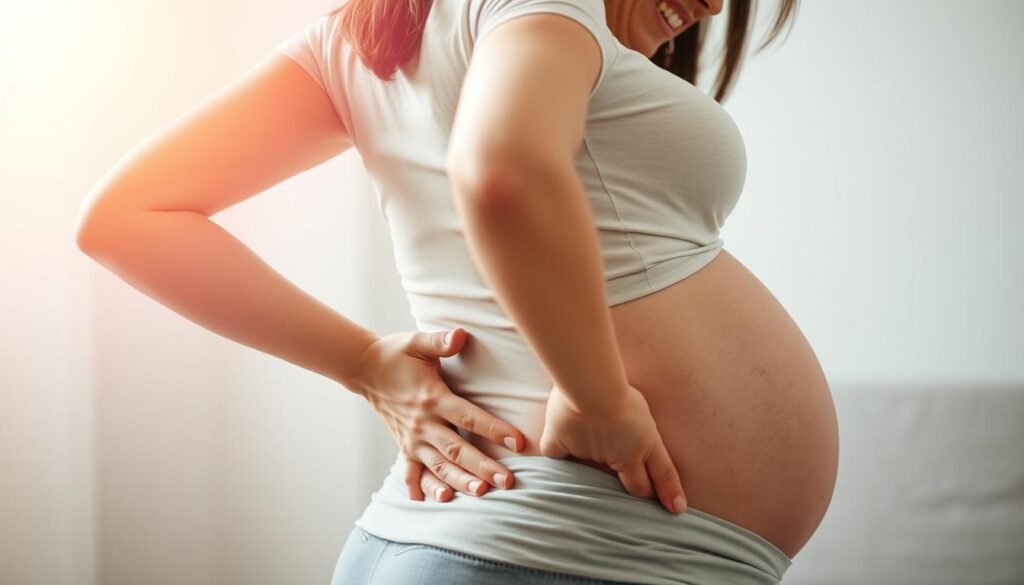Surprising fact: about 70% of women report new or worse spine discomfort by the third trimester, yet most find relief by the time they give birth.
This short guide explains why many expectant women feel strain and what simple steps help day to day. Hormonal shifts, extra weight, and a shifting center of gravity all play a role. Understanding these causes makes the solutions feel less mysterious.
Practical approaches—stretching, resting with feet raised, using a heating pad, and wearing support belts—can reduce discomfort without complex routines. Most people manage symptoms at home, but severe or changing symptoms should prompt contact with a care provider.
For easy, evidence-based tips you can try today, see this home remedies guide that fits busy schedules and real life.
Key Takeaways
- Spine discomfort is common in expectant women and often eases after birth.
- Simple actions—rest, gentle stretches, and support belts—can bring meaningful relief.
- Know when to contact your provider: worsening or unusual symptoms need evaluation.
- The goal is practical, safe strategies that work with daily life.
- Evidence-based tips help you feel more in control while you wait for long-term improvement.
Why your back hurts during pregnancy right now: common causes and what’s normal
Rising weight and a forward-tilting center of mass are core reasons the lower spine feels more stressed. A healthy gain of about 25–35 pounds shifts load to the lower back and can press on pelvic nerves and vessels.
How weight and center changes strain the lower back
As the baby grows, posture nudges forward. Small shifts add up and strand spinal tissues under extra work. Standing or long chores often make symptoms worse.
Hormones and loosened ligaments
The hormone relaxin softens pelvic ligaments to prepare for birth. That loosening can reduce joint stability, so the sacroiliac area becomes a common hotspot.
Posture, muscle separation, and stress
Diastasis of the rectus abdominis reduces core support. When abdominal muscles do not brace the trunk, spine muscles fatigue and spasm. Emotional stress makes muscles tighten and intensifies discomfort.
Quick checklist
| Cause | Effect on body | When you may notice it |
|---|---|---|
| Weight gain | More load on lower spine; nerve pressure | After long standing or walking |
| Center gravity shift | Forward posture; tissue strain | Gradual build-up over weeks |
| Relaxed ligaments | Pelvic instability; SI joint soreness | Turning in bed; standing up |
| Diastasis & stress | Weak core; muscle spasms | After heavy lifting or tense days |
Understanding these causes helps you try simple posture tweaks and rests. If symptoms change or worsen, consult a back pain during pregnancy resource or your care provider.
How to relieve back pain during pregnancy: safe, proven steps you can start today
Small habit shifts—movement, posture tweaks, and targeted support—often cut flare-ups within days.
Move wisely
Start with walking, swimming, or stationary cycling to strengthen core and hips. Short, regular sessions help muscles adapt without strain.
Heat and cold therapy
Use a cold pack for 15–20 minutes for the first 48–72 hours of a flare. Then switch to a heating pad or hot water bottle on the low setting to relax tight muscles. Do not apply heat to the abdomen.

Posture, sleep and support
Sit with lumbar support, feet elevated, and stand tall with shoulders back to reduce lower back strain from shifting center gravity. Sleep on your side with a pillow between the knees.
| Strategy | What it helps | When to use |
|---|---|---|
| Exercise (walk, swim) | Builds core and hip strength | Daily, short sessions |
| Heat/cold | Reduce inflammation, relax muscles | Cold first 48–72 hrs, then heat |
| Support belt | Limits pelvic motion | Long walks or tasks |
If symptoms persist, a trusted pregnancy guide or a referral to a physical therapist may recommend targeted treatments. For treatment options, see this overview of options.
When to call your obstetric care provider and treatment options they may recommend
Learn which warning signs need urgent review and which treatments your provider may order.
Warning signs
If you develop severe or sudden back or pain that is worse than usual, call your care provider right away.
Also report rhythmic cramping before 37 weeks, new numbness or tingling in the legs, or trouble urinating. These can signal labor or a nerve issue that needs prompt evaluation.
Fever, sudden joint swelling, or inability to stand or bear weight requires same-day assessment to rule out rare but serious conditions such as infection or bone problems.

Safe treatments and referrals your team may recommend
Your obstetric care team — OB-GYNs, certified nurse‑midwives, maternal‑fetal medicine specialists, or family physicians — will prioritize safety for you and the baby.
- Medications: Providers often suggest acetaminophen first and advise avoiding NSAIDs like ibuprofen or naproxen unless specifically cleared.
- Support devices: A pelvic support belt or lumbar cushion may be recommended for daily activities or long tasks.
- Referrals: Physical therapy for stabilization and tailored exercises is common. Some clinicians may also refer for acupuncture or supervised chiropractic care when appropriate.
When in doubt, report rhythmic, timeable waves of discomfort or any change in urine, bleeding, or fluid loss—these may mean labor is starting.
For guidance on when symptoms warrant urgent review, see this detailed resource: when to worry about lower back.
Conclusion
A few reliable habits usually ease symptoms and help you stay active and confident.
Most episodes of back pain pregnancy improve as the body recovers after birth. Keep using simple steps that may help: side‑sleeping with a pillow, comfortable shoes, short regular exercise, and frequent hydration.
Warm water routines — a brief soak or shower — can relax muscles and complement stretches and support garments. Track when discomfort spikes and adjust tasks to match energy levels.
If a day’s symptoms intensify or limit routine activities, contact your care provider. For guidance on when to seek specialist evaluation, see when to see a pain management expert.

